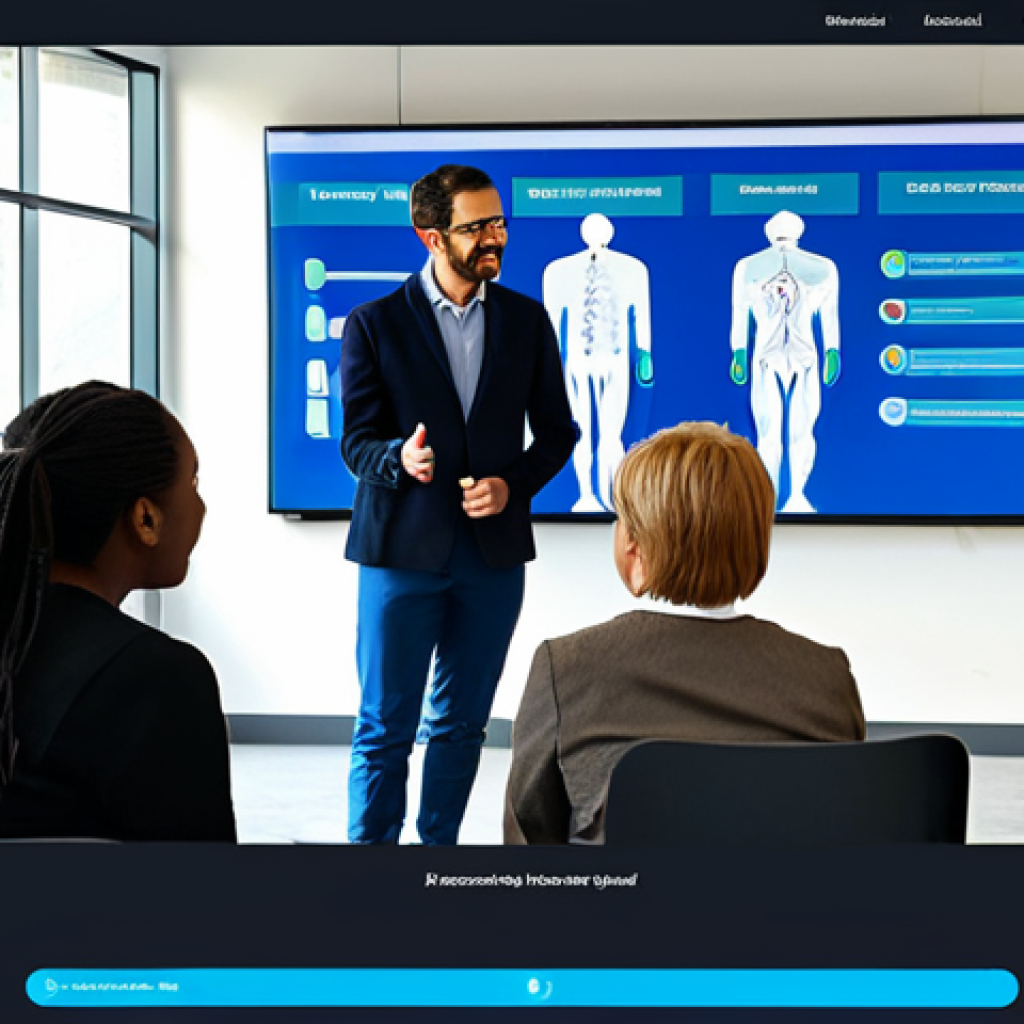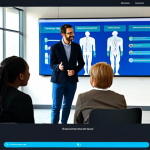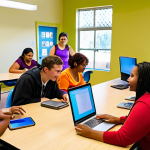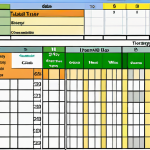There’s a deeply satisfying magic that unfolds when you watch someone, perhaps for the very first time, truly connect with a piece of information, or confidently navigate a digital landscape they once found intimidating.
As a literacy educator, I’ve had the privilege of witnessing countless such breakthroughs, and honestly, each one reinforces why I do what I do. I vividly recall Mark, a retired factory worker who, despite years of formal schooling, had never truly grasped the power of online research; seeing his eyes light up as he fact-checked a news story using skills we’d practiced was profoundly moving.
Yet, our role is continuously evolving. The learning environment today is a far cry from what it was even a decade ago. We’re contending with a deluge of information, the growing digital divide, and the pervasive influence of AI, which, while powerful, also demands new levels of critical evaluation and adaptability.
We’re not just imparting foundational skills anymore; we’re teaching resilience, digital fluency, and the ability to discern truth from fiction in an increasingly complex world.
It’s about crafting personalized learning journeys that leverage cutting-edge pedagogical techniques and even responsibly incorporate AI as a supportive tool, not a replacement.
This demands an intimate understanding of how people learn in the modern age, focusing on strategies that genuinely resonate and empower.
This demands an intimate understanding of how people learn in the modern age, focusing on strategies that genuinely resonate and empower. Let’s find out precisely.
Reimagining Engagement in Our Digital Landscape

1. Crafting Interactive Experiences, Not Just Information Delivery
The days of passively absorbing information are well and truly behind us. As someone who has spent years in the trenches, working directly with individuals struggling to find their footing in a sea of digital content, I’ve seen firsthand that true learning sparks when people are *doing*, not just *listening*.
It’s about creating environments where curiosity isn’t just permitted, but actively ignited. Think beyond lectures or simple readings; we’re talking about dynamic simulations, collaborative online projects, and real-time problem-solving scenarios that mirror the complexities of the world outside.
I remember Clara, a wonderfully bright woman in her late sixties, who initially struggled with basic computer navigation. Instead of just showing her a mouse, we set up a simple online scavenger hunt – she had to find three different types of virtual flowers.
The genuine delight on her face when she successfully clicked and dragged her first image, completing her “mission,” was palpable. That wasn’t just a technical skill acquisition; it was an emotional breakthrough, solidifying her belief that she *could* do this.
My experience has shown me that when learners are actively involved, when they feel a sense of agency and purpose in their learning journey, retention skyrockets, and the perceived difficulty of new concepts melts away.
We integrate gamified elements, not as a gimmick, but as a scaffold to build confidence and maintain momentum, turning what might feel like a chore into an exciting exploration.
This paradigm shift requires educators to become designers of experience, carefully curating interactions that challenge, support, and ultimately, empower.
2. Leveraging Storytelling and Empathy in Educational Design
Humans are inherently wired for stories. From the earliest cave paintings to the latest TikTok trends, narratives captivate us, making complex ideas accessible and relatable.
In my practice, I’ve found that weaving personal anecdotes, relatable scenarios, and even fictional narratives into learning modules dramatically increases engagement and comprehension.
It’s not just about what you teach, but how you frame it. When explaining online safety to a group of older adults, for instance, instead of rattling off a list of do’s and don’ts, I might share a hypothetical story about “Grandma Betty” who almost fell for a phishing scam, detailing her emotional journey from confusion to alarm to finally understanding.
This humanizes the threat, making it less abstract and far more memorable. Moreover, genuine empathy from the educator is paramount. When I’m sitting across from someone grappling with a new digital tool, I try to truly understand their unique anxieties, their past frustrations, and their specific goals.
This isn’t just good teaching; it’s fundamental to building trust. When learners feel seen and understood, they are far more likely to take risks, ask questions, and persist through challenges.
This deep connection, built on shared humanity and mutual respect, transforms a transactional learning experience into a truly transformative one. It’s a core principle of how I approach every single lesson, big or small.
Navigating the Deluge of Information in the Modern Age
1. Decoding Digital Trust and Source Verification
In an era where information spreads like wildfire, often without proper vetting, teaching people how to discern credible sources from misinformation has become as crucial as reading itself.
I’ve spent countless hours guiding learners through the labyrinth of online content, helping them develop a keen eye for red flags – sensational headlines, anonymous sources, or emotionally charged language designed to bypass critical thought.
It’s not enough to just say “check your sources”; we need to provide concrete, actionable strategies. We explore the anatomy of a reliable website, discuss the importance of cross-referencing information across multiple reputable outlets, and even practice reverse image searches to identify manipulated visuals.
My own experience has shown me the profound impact of this skill; I remember coaching a local community group that was deeply divided by conflicting information circulating online.
By applying simple fact-checking techniques, they were able to collectively identify the inaccuracies, leading to a much more informed and productive discussion.
This wasn’t just an academic exercise; it was about empowering them to make better decisions in their daily lives, based on truth rather than fabrication.
The ability to critically evaluate digital content is no longer a luxury; it’s a fundamental survival skill in our hyper-connected world, and it’s a constant point of emphasis in my work.
2. Cultivating Digital Mindfulness and Well-being
Beyond the content itself, the sheer volume and constant availability of digital information can take a significant toll on mental well-being. My journey as an educator has revealed a growing need to address digital mindfulness – teaching learners not just how to access information, but how to manage their consumption in a healthy, balanced way.
We talk openly about the addictive nature of social media feeds, the pressure to constantly be “on,” and the impact of information overload on focus and stress levels.
Practical strategies, such as setting screen time limits, curating information feeds to reduce noise, and practicing digital detoxes, are integrated into discussions.
It’s about empowering individuals to take control of their digital lives, rather than letting their devices control them. I’ve personally experimented with various app blockers and notification management techniques, and I share these real-world insights, emphasizing that technology should serve us, not the other way around.
My approach is holistic: it’s not enough to be digitally literate; one must also be digitally well. This means understanding when to unplug, how to protect personal boundaries online, and recognizing the subtle cues of digital fatigue.
This is a crucial, often overlooked, aspect of modern literacy that deeply impacts quality of life.
Empowering Learners Through Personalized Pathways
1. Tailoring Content to Individual Needs and Learning Styles
Every single person who walks through my (virtual or physical) door brings with them a unique tapestry of experiences, prior knowledge, anxieties, and aspirations.
Treating them as a monolithic group is a recipe for disengagement and frustration. From my perspective, true empowerment stems from recognizing and responding to these individual differences.
This means conducting thorough initial assessments, not just to gauge current skill levels, but to understand what genuinely motivates them, what their preferred learning modalities are, and what real-world problems they hope to solve.
For some, a visual approach with diagrams and videos might be best; for others, hands-on practice or auditory explanations might resonate more deeply.
I recall a young adult I worked with, struggling with complex text comprehension, who blossomed when we started using interactive mind maps and visual summaries.
It wasn’t about simplifying the content, but about presenting it in a way that aligned with how their brain processed information most effectively. My experience has shown me that flexibility is key – having a diverse toolkit of teaching methods and being ready to pivot based on real-time feedback from the learner.
This bespoke approach fosters a sense of being truly understood and valued, which is foundational for building confidence and sustained engagement.
2. Leveraging Adaptive Technologies for Customized Learning
The advent of adaptive learning technologies has been a game-changer in realizing truly personalized education at scale. These platforms, often powered by sophisticated algorithms, can assess a learner’s progress in real-time, identify areas of strength and weakness, and then dynamically adjust the difficulty, pace, and even the type of content presented.
While no technology can replace the human touch of a dedicated educator, these tools can act as powerful co-pilots, providing immediate feedback and targeted practice that would be impossible to deliver manually for every single learner.
I’ve experimented with various adaptive reading platforms that highlight challenging vocabulary or rephrase complex sentences based on a learner’s past performance, and the results have been remarkable.
The self-correction and iterative learning cycles these tools enable significantly accelerate progress. However, it’s crucial to use them judiciously.
It’s not about handing over control to an algorithm, but about using the data and insights provided by these tools to inform and enhance the human-led instruction.
My approach is always to blend the best of both worlds: high-tech insights combined with high-touch personal guidance, ensuring that the technology serves to augment, not diminish, the human learning experience.
Bridging the Digital Divide with Empathy and Action
1. Addressing Access Barriers Beyond Just Hardware
When we talk about the digital divide, it’s easy to focus solely on the lack of devices or internet access. And while these are undeniably critical issues, my on-the-ground experience has consistently shown me that the divide is far more nuanced and multi-faceted.
It’s not just about having a laptop; it’s about having reliable, affordable broadband, understanding how to maintain the device, and possessing the foundational digital literacy skills to use it effectively and safely.
For many, the cost of data plans or the complexity of setting up a home network can be just as significant a barrier as the initial price of a computer.
I’ve worked with families who had a tablet but no knowledge of how to connect to public Wi-Fi, or individuals who hesitated to use online banking due to deep-seated fears about scams.
My advocacy extends to connecting learners with community resources for affordable internet, helping them troubleshoot basic technical issues, and patiently guiding them through their initial digital interactions.
It’s an holistic approach that recognizes the interconnectedness of infrastructure, affordability, and human capability. We actively seek out partnerships with local libraries, community centers, and non-profits to create accessible learning hubs, understanding that a device without the ecosystem to support its use is often just a very expensive paperweight.
2. Cultivating Digital Citizenship and Ethical Use
Simply giving someone access to the internet without concurrently teaching them how to be a responsible, ethical digital citizen is akin to giving someone a driver’s license without teaching them traffic laws.
The digital realm comes with its own set of responsibilities, and fostering digital citizenship is a cornerstone of my educational philosophy. This involves discussions around online etiquette, respecting intellectual property, understanding privacy settings, and recognizing the impact of our digital footprints.
We delve into real-world scenarios, like the consequences of cyberbullying or the importance of critical thinking before sharing viral content. It’s about empowering individuals to navigate the online world not just safely, but also ethically and with integrity.
My goal is to cultivate a generation of digital citizens who understand their rights and responsibilities, who can contribute positively to online communities, and who can advocate for a more inclusive and respectful digital space.
This goes beyond mere technical proficiency; it delves into the moral and social dimensions of living in an interconnected world, ensuring that learners are not just users of technology, but responsible architects of their digital future.
The Ever-Evolving Role of the Modern Educator
1. From Instructor to Facilitator and Lifelong Learner
The traditional image of an educator as the sole dispenser of knowledge no longer fits the dynamic demands of our current information age. My journey has continually reaffirmed that our role has fundamentally shifted from being instructors to becoming facilitators of learning, guides on the side rather than sages on the stage.
This means cultivating an environment where learners feel empowered to explore, question, and discover knowledge for themselves, with us providing the tools, structure, and empathetic support needed to navigate challenges.
It also necessitates that we, as educators, embrace the concept of being perpetual learners ourselves. The digital landscape evolves at an incredible pace, and what was cutting-edge last year might be obsolete today.
I dedicate significant time to staying abreast of new technologies, pedagogical research, and emerging trends in digital literacy. Whether it’s experimenting with new AI tools in a learning context, exploring different online collaboration platforms, or simply keeping up with the latest scamming tactics, this commitment to continuous learning is non-negotiable.
It’s not just about imparting knowledge; it’s about modeling the curiosity and adaptability we hope to instill in our learners. This commitment to continuous self-improvement ensures that the guidance we offer is always relevant, practical, and forward-thinking.
| Aspect | Traditional Literacy Education | Modern Literacy Education (Today) |
|---|---|---|
| Primary Focus | Reading, writing, basic arithmetic in print. | Critical evaluation of digital content, media literacy, digital communication, ethical AI use, online safety. |
| Learning Environment | Primarily classroom-based, physical materials. | Blended (online/offline), virtual platforms, diverse digital tools, adaptable to remote learning. |
| Educator Role | Knowledge dispenser, lecturer, content expert. | Facilitator, guide, critical thinking coach, curator of digital resources, lifelong learner. |
| Learner Engagement | Passive absorption, rote memorization, individual tasks. | Active participation, collaborative projects, problem-solving, real-world application, personalized pathways. |
| Key Skills Developed | Decoding text, penmanship, basic comprehension. | Digital discernment, information synthesis, adaptive problem-solving, digital citizenship, resilience, computational thinking. |
2. Fostering Resilience and Adaptability in Learners
One of the most profound lessons I’ve learned from years of working in education is that true learning isn’t just about acquiring facts or skills; it’s about developing the inner fortitude to navigate uncertainty and embrace continuous change.
In an age where job roles are shifting, technologies are evolving, and the information landscape is constantly in flux, resilience and adaptability have become paramount.
My approach involves not just teaching *what* to learn, but *how* to learn, and more importantly, how to recover from setbacks. When a learner encounters a technical glitch or struggles to grasp a complex concept, instead of immediately providing the answer, I guide them through a problem-solving process.
We discuss debugging strategies, the value of persistence, and the importance of seeing mistakes as learning opportunities rather than failures. I share my own stories of digital mishaps and learning curves, humanizing the struggle and demonstrating that even experienced professionals face challenges.
This cultivates a growth mindset, empowering individuals to approach new technologies and unfamiliar situations with confidence rather than fear. It’s about building an internal compass that can guide them through any future digital landscape, ensuring they are not just literate for today, but prepared for tomorrow’s unknown challenges, fostering a deep-seated belief in their own capacity for ongoing growth and mastery.
Fostering a Culture of Lifelong Curiosity
1. Igniting the Intrinsic Motivation to Learn
The most effective learning, in my experience, is rarely externally imposed; it’s intrinsically motivated, stemming from a genuine desire to understand, explore, and grow.
As an educator, my ultimate goal is to ignite that spark of curiosity and cultivate a lifelong love of learning, particularly in the digital realm. This means connecting new concepts to learners’ existing passions, interests, and real-world needs.
Instead of teaching spreadsheet functions in a vacuum, we might apply them to budgeting for a dream vacation or tracking personal fitness goals. When working with a group of hobbyists, I might introduce them to online forums or digital tools that can enhance their craft.
It’s about demonstrating the immediate relevance and practical utility of digital skills, transforming them from abstract requirements into powerful enablers of personal fulfillment.
I often share stories of how digital tools have allowed me to pursue my own curiosities, whether it’s learning a new language through apps or researching obscure historical facts online.
The excitement that bubbles up when someone discovers how technology can genuinely enrich their life, whether through connecting with distant relatives or mastering a new skill, is incredibly rewarding.
This shift from obligation to exploration is critical for sustained engagement and genuine mastery in a world that constantly demands new literacies.
2. Building Collaborative Digital Learning Communities
Learning, especially in the modern age, is rarely a solitary endeavor. The power of collective intelligence and peer support within a digital community cannot be overstated.
From my vantage point, fostering these collaborative environments is essential for nurturing curiosity and ensuring ongoing engagement. We encourage learners to share their challenges and successes in online forums, participate in group projects, and even teach concepts to one another.
This peer-to-peer interaction not only reinforces learning but also builds confidence and a sense of belonging. I’ve witnessed shy individuals, initially hesitant to speak in a traditional classroom setting, flourish within a supportive online group where they felt comfortable asking “silly” questions or sharing their personal breakthroughs.
These communities provide a safe space for experimentation and mutual encouragement, allowing learners to see that they are not alone in their struggles and that there’s immense value in diverse perspectives.
Furthermore, participating in such communities helps develop crucial 21st-century skills like digital communication, online etiquette, and collaborative problem-solving, preparing them not just for academic success but for the interconnected professional world.
My role extends beyond direct instruction to actively cultivating and nurturing these digital ecosystems, ensuring they are inclusive, respectful, and conducive to a shared journey of discovery and growth.
Closing Thoughts
As I reflect on the journey we’ve embarked upon, exploring the multifaceted landscape of modern literacy, one truth resonates above all else: education today is less about filling a pail and more about lighting a fire.
My experiences, from guiding Clara through her first digital scavenger hunt to witnessing community groups reclaim their narrative by verifying sources, have consistently reinforced the profound impact of personalized, empathetic, and resilient learning.
This isn’t just about mastering tools; it’s about cultivating a mindset of continuous discovery, fostering genuine human connections, and empowering every individual to thrive in a world that never stops evolving.
The future of literacy is vibrant, inclusive, and deeply human.
Useful Information
1. Explore Local Library Digital Resources: Many public libraries offer free online courses, digital literacy workshops, and even one-on-one tech help. It’s an often-underestimated community asset.
2. Practice Digital Decluttering: Regularly review your subscriptions, social media follows, and digital files. A cleaner digital space can significantly reduce mental clutter and improve focus.
3. Utilize Browser Extensions for Source Verification: Tools like NewsGuard or the B.S. Detector (though less formal) can provide quick insights into the credibility of a website, helping you become a savvier online reader.
4. Engage with Online Learning Platforms: Websites like Coursera, edX, or even YouTube offer countless free and paid courses on digital skills, from coding to graphic design, catering to diverse interests and learning styles.
5. Set Intentional Screen Time Limits: Use your phone or computer’s built-in features to monitor and limit app usage. Being mindful of how much time you spend online can dramatically improve your digital well-being.
Key Takeaways
Modern literacy extends beyond traditional reading and writing to encompass critical digital discernment, ethical online conduct, and continuous adaptation.
True education fosters resilience, empathy, and a lifelong intrinsic motivation to learn, leveraging technology to empower individuals and build inclusive digital communities.
Frequently Asked Questions (FAQ) 📖
Q: What does “Let’s find out precisely” actually entail in our everyday lives, especially when the sheer volume of information feels paralyzing?
A: Oh, that’s a question I hear all the time! For me, “Let’s find out precisely” isn’t about becoming a scholar overnight; it’s about shifting from passively absorbing information – or worse, just ignoring it – to actively engaging with it.
I remember my neighbor, Brenda, who was just swamped trying to understand all the new health guidelines during the pandemic. She felt completely overwhelmed.
When we sat down, “precisely” meant breaking it down: identifying exactly what she needed to know, finding reliable sources like the CDC or NHS, and then, crucially, double-checking across a couple of trusted sites.
It’s about cutting through the noise, asking pointed questions, and refusing to settle for vague or unchallenged claims. It’s like being a detective for your own understanding, piece by piece.
That focused approach, it just lifts a huge weight, you know?
Q: How does this “finding out precisely” approach help us navigate the wild, wild west of
A: I-generated content and rampant misinformation? A2: That’s where the rubber really meets the road, isn’t it? It’s no longer just about reading; it’s about interrogating what you read.
When AI can churn out convincing-sounding articles in seconds, “precisely” means cultivating a healthy skepticism. I recently worked with a group of high schoolers who were convinced a deepfake video was real.
Our “precisely” moment was dissecting it: looking for inconsistencies, checking the source’s reputation, doing a reverse image search. It’s teaching yourself to ask, “Who made this?
Why? What’s their agenda?” and then going a step further to verify. It’s no longer enough to just see something; you have to trace it, understand its origins, and assess its true intent.
It’s about building a robust internal filter, because the digital world isn’t going to filter itself for us.
Q: Is “Let’s find out precisely” really applicable beyond academic settings – perhaps for just making better personal choices or decisions?
A: Absolutely, and in my experience, that’s where it truly shines! Think about it: buying a new car, deciding on a mortgage, even figuring out the best route to avoid traffic – these are all moments where “finding out precisely” comes into play.
I once helped a friend who was about to sign up for a new home internet plan. She was just going to pick the cheapest one. Our “precisely” conversation involved digging into not just the monthly cost, but the actual speed, data caps, customer service reviews, and what existing customers in our area were saying.
It meant reading the fine print, asking the salesperson specific questions, and comparing competitor offers based on her actual usage, not just marketing fluff.
That level of precision saved her money and a lot of headaches down the line. It’s about empowering yourself to make truly informed decisions in every corner of your life, big or small.
It’s empowering, genuinely.
📚 References
Wikipedia Encyclopedia
구글 검색 결과
구글 검색 결과
구글 검색 결과
구글 검색 결과
구글 검색 결과





